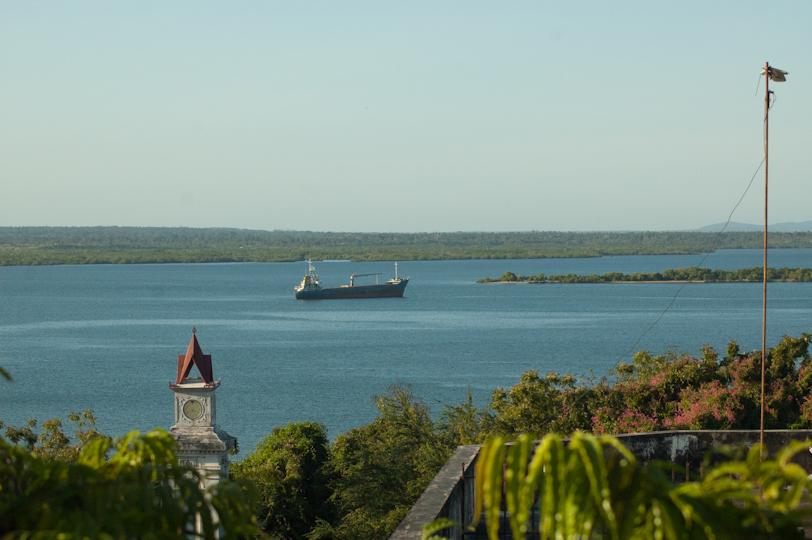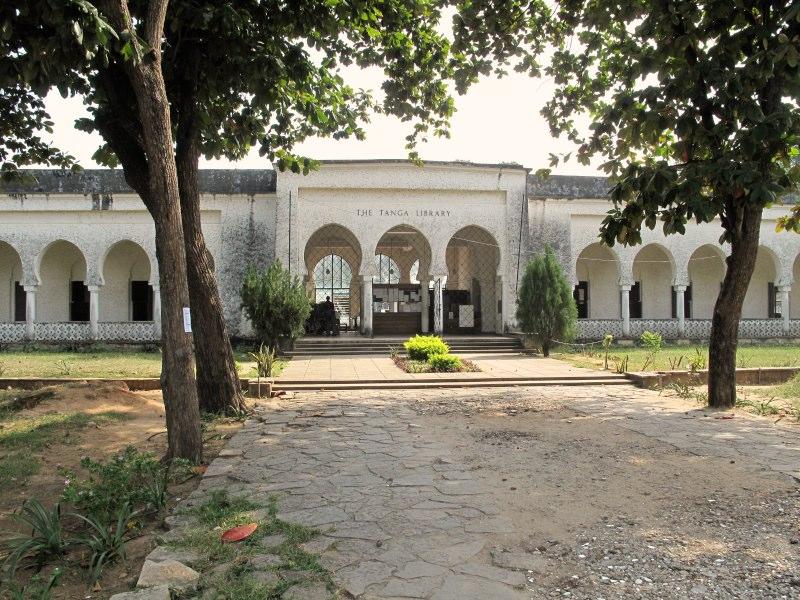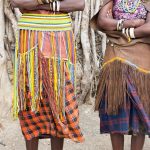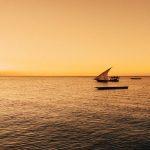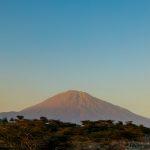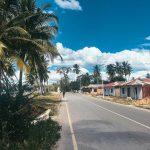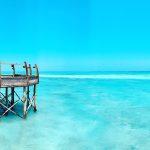This is a complete travel guide to Pangani and Tanga in Tanzania. Here you’ll discover all the things to do in Tanga and the history of Tanzania’s third-largest city and the second-most important port in the Indian Ocean. As well as the sleepy little town of Pangani, on the banks of the Pangani river, 66km south of Tanga.
Don’t miss our other Tanzania Cadogan Guides:
The wide and shady avenues of Tanga are the first clue to its past. It is evident within minutes of arrival that Tanga was once a popular colonial and industrial centre, complete with strict town-planning, immaculate roads, a fine looking hospital, police posts and an imposing gaol. But the huge steel hulks of old ships have turned to rust in the old harbour, and paving stones are loose and sporadically sprouting weeds.
These are signs of a far greater misfortune that has befallen the once fine town that thrived here, but which has since suffered harsh economic decline. It hardly feels large enough to classify as Tanzania’s third largest city, or its second-most important port, but it is extensive enough to have developed several distinct areas.
Row upon row of small swahili houses and shops extend southwards behind the railway line reminiscent of purpose-built workers accommodation dating from the Industrial Revolution, and the thousands of people who live here are a generous mix of the numerous main regional tribes, with many others besides.
Exploring the town a little further brings you to the looping coastal road around the peninsula called Ras Kazone. Here a number of large, detached residential houses sit sleepily in the sunshine, soaking up a salty air of bygone beachside elegance that this waterfront with its sailing club and swimming club and grand old hotels once nurtured.
The History of Tanga, Tanzania
When the British explorer Burton visited the settlement of Tanga in 1857 he described a collection of ‘thatch pent-roofed huts, built upon a bank overlooking the sea.’ He estimated the local population to be between 4 and 5 thousand people, including around fifteen Baluchis and twenty Indian merchants, all held in check by the Sultans troops under his appointed ‘Wali’, or governor.
So, when the German East Africa Company came here in 1888, following their success in persuading the Sultan to lease them a 16km wide strip along the coastline of Tanzania, Tanga was a relatively small fishing village that would have sustained a certain amount of commercial trade with Bagamoyo. The town sent annual caravans into the Usambara, Pare, Kilimanjaro and Maasai regions to return laden with ivory for sale.
Tribes of Tanga
There were a handful of Omani residents who chose a quieter life here north of the central port town, but in essence, this was a rural region occupied by a number of distinct and different tribes. These include the Digo people and the Bondei, whose name means ‘of the valley’, originally from Kenya but each squeezed south by their neighbors, and the Shambaa and the Pare people from the nearby Usambara and Pare mountains, also extending southwards.
Another migrant group was the Segeju, who are less in evidence today, probably as a result of intermarrying, but they are considered responsible for building a number of protective walled enclosures around the Tanga region, thought to have been built during the 19th century as a defense against the Maasai. Some of these, however, have angled spy holes similar to those at the ‘Gereza’ at Kilwa and Fort Jesus in Mombassa, which may indicate Arab influences in design and construction.
The Zigua people remained on their turf just south of Tanga, perhaps the original people of the Tanga region, and developed an impressive reputation for keeping themselves to themselves but responding with violent aggression when challenged. They have become a large tribe, taking many wives and remaining generally resistant to missionaries pushing for schooling in return for taking on the Christian faith.
All of these people and other neighbouring tribes were familiar with the commercial exchange provided by the proximity of the caravan routes, but perhaps none were prepared for the advent of the new German port.
The Port of Tanga
At the end of the 19th century the first colonial power had begun work to develop the small port of Tanga to accommodate their steam ships after the port of Bagamoyo proved too shallow, and soon after, in 1893, they completed a railway line from Moshi to Tanga.
In the same year, the first school in Tanzania was built and run initially by the German Colonial Society, and then soon after it was taken over by the government. The school developed quite a reputation for rigorous discipline, to the extent that it was meted out with canes and chains, but was evidently successful in organising a structure of education that focused on learning the German language, reading, writing and craft skills.
The fertile lands around Tanga and up into the Usambara mountains were very soon cultivated and proved profitable. Extensive sisal plantations were laid out, but further progression was thwarted by the outset of World War One.
First World War
Tanga was then the site of one of the most infamous military blunders in East Africa. Thousands of Allied Troops were dispatched to lay a surprise attack on the Germans along the Tanga coastline, although the surprise was theirs when they arrived to find the dense mangroves along the beaches almost impenetrable, and the German troops fully prepared for their arrival. They were repulsed further by an aggressive swarm of disturbed bees, and were forced to abandon crucial supplies and weapons in retreat.
An estimated 800 men died, with almost as many injured, in various ways. This episode and other events of the First World War on Tanzanian soil are excellently if imaginatively, recounted in William Boyd’s novel, The Ice-Cream War.
Sisal Plantations
In the years following the war, the population of Tanga was curiously altered as the German settlers moved away and the sisal plantations were taken over by a feisty contingent of Greek farmers. These developed a wild reputation for popular gambling sessions, during which entire estates might change hands, and enjoyed enormous prosperity from their sisal crops until the mid 1950s, when sisal prices crashed.
The crop has never really recovered as a result of the proliferation of manufactured fibres, although it is still worthwhile for many of the smaller, recently privatised farms, but the population of Tanga today is largely dependent on local dhow trade with the Tanzanian and Kenyan coast, and the cement and brick factories that are situated just west of the town.
Things to do in Tanga, Tanzania: Around town and local activities
The Tanga Ropeworks near the Post Office at the centre of town has examples of the various ropes made from sisal, once the lifeline for the town’s prosperity. This is opposite the old German-built Court House, which remains an imposing and good-looking structure that still functions as a ministration of law and order.
A walk along Independence Avenue, parallel to the sea front, leads past the Clock Tower erected in 1961, towards the Library, a substantial building in front of a pleasant arched courtyard that was opened by the British Governor Sir Edward Twining in the mid-1950s.
Just west of the Library along Independence Road brings you to the Old Boma, large, heavy and imposing, and situated in a prime position overlooking the old harbour.
A more curious and attractive legacy of this colonial era can be found a couple of blocks directly south, where the quaint and seemingly entirely unchanged railway station seems to have been lifted straight from a picture book of European country stations a century ago. Sadly this route is no longer functioning for passengers. To get here, walk through the Uhuru Park and follow Station Road south. Tanga School is situated on the eastern aspect of the park.
If you are looking for a bespoke itinerary in Tanzania, don’t miss our Tanzania Safari page or contact us!
Where to visit around Tanga
Amboni Caves in Tanga
Just 8km north of Tanga, Amboni Caves are a good and exciting diversion if you have a little time to spend in Tanga. These are a protected portion of over 207 km of limestone caves dating from the Jurassic age, which have inspired a number of mystical legends in their time.
Local people have traditionally regarded the strange formation as being supernatural, and call them Mzimu wa Mabavu, the dwelling of a powerful deity. For this reason people come from all surrounding areas to offer prayers and sacrifices, seeking cures from sickness, suffering or lack of fertility, and in certain areas you will find dusty bottles of oil, perfumes and charred incense.
History tells how these caves proved a formidable sanctuary for certain individuals during the Mau Mau rebellion in Kenya, particularly the now legendary Elias Samuel Oselloetango, who continually thwarted the British attempts to capture him. This evasive anti-hero used these caves to hide with Paulo Hamisi between 1952 and 1956, and during those years managed to spread all manner of tales about his exploits vanishing from prison cells and living in this underground maze. An unappealing description of his scarred, dark, heavy complexion and lock of curly hair hanging low on his forehead brings the legend to life on yellowing ‘wanted’ posters hanging in the guide’s hut.
The caves are under the protection of the Antiquities Act of 1964, and it is possible to take a guided tour through many of the caves at Amboni. These exceptional natural rock formations are distinctly impressive but do not expect more from the ‘guided tour’ than a man with a torch leading through the maze and pointing out odd stalactite formations that seem to have the appearance of the Virgin Mary, or a roaring lion.
Finally he points out ‘Kilimanjaro’, while you are standing at the bottom of a very steep pile of rocks, from the top of which the path continues. Nevertheless, it is absolutely imperative to take a guide, as fatalities have been incurred when individuals have gone in alone. The tour is great fun, but not recommended for claustrophobics, vertigo-sufferers, or anyone nervous about climbing, squeezing and scrambling through often quite small dark spaces.
The honeycomb cave maze is liberally inhabited by bats and absolutely unlit. Entrance with a guide is Tsh 1000 per person.
Tanga – Tongoni Ruins
Near the village of Tongoni, 20 km south of Tanga town off the Tanga-Pangani road, there are ruins of a much older settlement of the same name that date from the 13th to 16th centuries, as well as mosques, tombs and defensive walls from the 18th and 19th centuries.
Many of these older sites are now thickly overgrown, and access to many is difficult or impossible.
‘Tongoni’ is a Swahili term meaning place of ruins, or more literally ‘forsaken place’, although it is said that more recent inhabitants called the place ‘Sitahabu’, meaning ‘better here than there’.
These were ancestors of some inhabitants of present day Tongoni, remembered as ‘Shirazi’ migrants from Kilwa who found the ruins deserted and occupied some of the old houses. Perhaps a few generations passed before the earlier alternative was forgotten and their home was re-christened Tongoni.
Remains of the most ancient settlement at Tongoni are mainly found to the North and East of the ruined large central Mosque and tombs, which notably include a number of 14th to 15th century pillar tombs.
The pillars have scalloped indentations that would have once been decorated with glazed porcelain saucers, as seen at the domed mosque at Kilwa, but none of these pieces remain intact. Many have extensive frieze work carved around.
A plain, double walled tomb near a fallen pillar tomb that rests on the east wall is considered significantly spiritual, as local tradition tells how this is the tomb of a Shariff, a descendent of Prophet Mohammed. People still bring offerings here, especially women hoping for children.
How to get around Tanga Tanzania
Tanga is largely navigable on foot, although this can mean covering a fair old distance if you are keen to explore the town centre, the Raskazone peninsula and more.
It is possible and worthwhile to hire a bicycle, especially if you are energetic enough to cover the kilometres to Amboni Caves as well, and these can be rented for around Tsh100-200 per hour from the roundabout between the bus stand and the train station on Taifa Road.
Learn more about Tanzania Islands and Beach Towns:
- Zanzibar Island
- Pemba Island
- Chole Island
- Mafia Island
- The South Coast of Tanzania: Lindi, Mikindani and Mtwara
- The Indian Ocean Coast: Bagamoyo
- The Indian Ocean Coast: Kilwa
Pangani, Tanzania
Pangani is a little town on the banks of the Pangani (Ruvu) river, 66km south of Tanga. A ferry service shuttles to and from between the ancient old town of Bwemi with its crumbling mosques and Arabic houses on the south bank and the quietly dilapidating ‘new’ town where a number of grand ruins from all its eras of government act as a reminder of a once more glorious past.
These slow wooden motor boats wait at each shore until they are filled, and a loud general banter bubbles up between the gradually increasing cargo of colourfully swathed passengers. No one is hurrying, and time seems to drift as if on the lazy ebb and flow of the river and sea beyond.
But there are signs of quiet industry at the old warehouses and factory sites along the river, where groups of men congregate to work on mending nets or gathering baskets of coconuts or husks. Beyond, clusters of single storey swahili houses are variously painted and coloured with signs and women sit under shady verandas in their coloured kangas selling bundles of delicious honeyed rice cake.
History of Pangani
There is a possibility that little Pangani Town once featured more impressively in the realms of history, if indeed it was the site of the ancient Market town of Rhapta, as described in The Periplus of the Erythraen Sea, the 1st century guide to trade ports of Arabia, Eastern Africa and India.
This book described the coast of Azania, and told how the trading port of Rhapta was situated at a great river mouth, south of the ‘Mountains of the Moon.’ It is generally agreed that Rhapta must have been in present day Tanzania, but no remains have been found. The likelihood is that the great river mouth has finally swallowed up the old town, amid the silt deposits either here at Pangani, or alternatively further south near the great Rufiji River Delta.
The old mosques on the southern banks of the Pangani river suggest that there was a very early Muslim settlement here, and local stories tell of ruins of a great palace that has since succumbed to the wiles of nature, wound with the roots of great fig trees and crumbled to dust with the erosion of the cliff. There area a number of graves and ruins of ancient Muslim settlements in villages around Pangani that all date from the 14th century and later, although none have been found to be earlier.
It is known that Pangani was occupied by the Portuguese for a time, and that thereafter more Arab traders began to settle here throughout the 18th century. They made a certain amount of business and trading with the resident local Zigua tribe, selling belts and beads in exchange for food. Arabs and locals developed a good understanding and mutual reliance on the other, and the town remained a fairly quiet and low profile dhow port until the mid-1800s.
Once again the writings of explorer Richard Burton shed light on the exact situation at this time, for when he visited in 1857 he recorded the annual export trade as being 35,000lbs of ivory, 1,750lbs of rhinoceros horn and 160lbs of hippopotamus teeth. All this alongside a day to day trade in mangrove poles and maize.
Around this time, life in Pangani began to alter dramatically, as ‘Shirazi’ residents began to increase trade links along the Pangani River until the port developed into a major terminus for trade in ivory and slaves, the last stop for the overland caravan route from Lake Tanganyika. The Arab population developed a smart white-washed town beneath the minaret of a central mosque, and the town was surrounded by successful tobacco and sugar plantations.
But the social structure was then most dramatically altered when German colonialists shouldered their way into command the Sultan’s domain on the mainland immediately after the death of Sultan Barghash in 1888 and their subsequent agreement signed with his poor brother Khalifa. The German colonialists called Arab residents to positions of government in exchange for fine stone houses that they had built in the area, and then demanded that the Sultans officials, called akida, levy a mass of new taxes, including on burial, inheritance and property.
Anyone who failed to register his property and situation was liable to have it confiscated. Locals tell how the early colonial methods of discipline relied heavily upon the force of a beating stick, and relate (with a certain awe), how one colonial administrator developed such a talent with his stick that he was even able to defend himself from the jaws of a man-eating lion. Legend relates that he came out the victor in a fatal combat with a man-eating lion.
The ‘Bushiri’ revolt
In 1888 Pangani was chosen by Sheikh Bushiri ibn Salim al-Harthi as the centre for the infamous rebellion against German colonial rule, after a young German official named Emil von Zewlewsky, known as ‘Nyundo’, the hammer, in Swahili, heavy-handedly threatened the Sultan’s officer, insulted the Muslim religion and ‘sneered at the Sultan’. In order to quell any possible dissension against his rule, Zewlewsky then ordered 100 marines onto the beach to smash property and pull down the Sultan’s flag.
Bushiri was incensed. He was a proud, high born Arab, immaculately and expensively dressed and vehemently held his own al-Harthi community to be equally as rightful to the land as the Sultan. The Sheikh organised a group of militant dissidents against the German occupiers, digging trenches and fortifying their houses, including blockading Zelewsky in his headquarters, and he raised a rampant army of about 20,000 wild tribesmen, Arabs, Muslims, non-Muslims, slave traders and slaves.
There was evidently some confusion over the exact purpose of the army. While some thought they were defending the lands of the Sultan, Bushiri himself had plans to prove himself as an independent warlord. The only unifying theme was a certain uncontrollable anger against the German colonialists.
His army was successful in keeping their foe from their beaches for a time, but the supremacy of Bismark was not to be mocked, and before long greater forces were despatched from Europe. The unrest was quelled by May 1889, when a new imperial commissioner, Major Herman von Wissman was appointed in Pangani to placate the already slightly cooling rabble with the force of seven warships, extensive modern weaponry and numerous Sudanese and ‘Zulu’ troops. By June Wissman had recaptured Saadani and then Pangani, and in December Bushiri was captured as a result of the huge reward money on his head, and he and his collaborators were publicly executed.
The German powers were victorious, and thereafter continued to stake their claim on Tanganyika territory with a daring amount of warfare and village burning. Not all survived the attacks however, and suffice it to say that young Zelewsky ‘the hammer’ met his fate at the hands Chief Mkwawa’s Hehe warriors near Iringa.
The Pangani residents were still reeling from the violence of the German methods of administration, and consequently felt a welcoming response to the less draconian regimes of the new British government after WWII.
Although the British were more communicative and intuitive to the local people, they continued to rely on the Arab chiefs created by the Germans and strictly enforced tax payments with a penalty of imprisonment on those who did not pay. The British era saw an emphatic growth of schools and education, free to all whom wished to attend, although influenced by the crucial caveat that those who took advantage of these should follow the Christian religion.
The divide between Muslim and Christian is quite even in this region, and depended on the receptive attitudes of families and tribes to this stricture for potential education. The old people of Pangani remember the latter years of the colonial era with fondness, as a time of good business and wealth emmanating from the sisal (mkonge) plantations.
Four large estates around Pangani, at Sakura, Kibinda, Mwera and Bushiri did very well, and continued to do so for a while after Independence. But as the price for sisal began to drop and salaries were reduced, people began rather despondently wishing for a return of the old protectorate. As the sisal harvests lost their value the people planted coconut plantations, which were profitable for a while. But the trees have aged and the crops decreased considerably.
There is now little work for Pangani locals beyond a basic subsistence reliant on coconut, fish and small seasonal crops, and the employment level has officially dropped to 10%, compared with a rumoured nearly 100% under the British government. Worse is a widespread memory of better times, and many Pangani youth are forced to move away to Arusha or Dar es Salaam for work.

